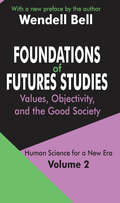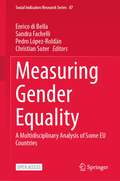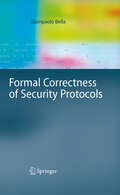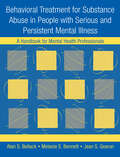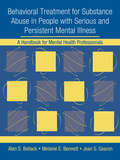- Table View
- List View
Interrogating Incest: Feminism, Foucault and the Law (Sociology of Law and Crime)
by Vikki BellWinner of British Sociological Association Philip Abrams Memorial Prize 1993 Within feminism incest has often been subsumed under a discussion of sexual violence and abuse. Yet, important as this is, there has been little account of how feminist work itself relates to other ways of talking about and understanding incest.In Interrogating Incest Vikki Bell focuses on the issue of incest and its place in sociological theory, feminist theory and criminal law. By examining incest from a critical Foucauldian framework she considers how feminist discourse on incest itself fits into existing ways of talking about sex. Closely surveying the historical background to incest legislation and the theoretical issues involve, Vikki Bell delineates their practical implications and shows what uncomfortable questions and important dilemmas are raised by the criminalisation of incest.
Interrogating Incest: Feminism, Foucault and the Law (Sociology of Law and Crime)
by Vikki BellWinner of British Sociological Association Philip Abrams Memorial Prize 1993 Within feminism incest has often been subsumed under a discussion of sexual violence and abuse. Yet, important as this is, there has been little account of how feminist work itself relates to other ways of talking about and understanding incest.In Interrogating Incest Vikki Bell focuses on the issue of incest and its place in sociological theory, feminist theory and criminal law. By examining incest from a critical Foucauldian framework she considers how feminist discourse on incest itself fits into existing ways of talking about sex. Closely surveying the historical background to incest legislation and the theoretical issues involve, Vikki Bell delineates their practical implications and shows what uncomfortable questions and important dilemmas are raised by the criminalisation of incest.
The Laboratory Cockroach: Experiments in cockroach anatomy, physiology and behavior
by W. J. BellCockroaches are ideal subjects for laboratory investigation at all educational levels. Compared with many other laboratory animals, cockroaches are easily and inexpensively maintained and cultured and require relatively little space. They are hardy and are readily available. The purpose of this book is to provide background material and experimental leads for utilizing cockroaches in the teaching laboratory and in designing research projects. The level of difficulty of the experiments varies according to the depth of understanding desi red by the instructor. In most cases at least a part of each experiment or technique can be incorporated into the laboratory component of elementary, high school or college curriculum. Sections of the lab book are appropriate for courses in Animal Behavior, Entomology, Organismic Biology and Insect Physiology. Aside from this main purpose, the book also provides a wealth of experimental ideas and techniques for a scientist at any level of education. Lawrence, Kansas June 15, 1981 W. J. B. ACKNOWLEDGEMENTS. Virtually all graduate students who have worked on cockroach research in my laboratory have knowingly or unknowingly contributed to this book. The most important contribution was from Sandy Jones McPeak, who encouraged me to finish the project. Segments of various chapters were conceived, developed or reviewed by Michael D. Breed, Sandy Jones McPeak, Michael K. Rust, Coby Schal, Thomas R. Tobin, W. Alexander Hawkins, Gary R. Sams and Chris Parsons Sams.
The Philippines in World War II, 1941-1945: A Chronology and Select Annotated Bibliography of Books and Articles in English (Bibliographies and Indexes in Military Studies)
by Walter F. BellBecause of their strategic location, the Philippines exercised a profound influence in the thinking of both Japanese and American strategists before and during World War II. A number of controversies surrounding the preparations for war, the initial defense of the islands, the Japanese occupation, the conduct of guerrilla operations, and the 1944-1945 American campaign to retake the islands still draw the interest of students and scholars. This work provides a finding aid for individuals seeking to deal with these issues. A bibliographic overview of available periodical and book literature in English, this book is multidimensional, encompassing all aspects—military, political, economic, and social—of the Pacific War as it relates to developments in the archipelago.The book is an essential source for those looking for insights into the war's impact on Philippine society and also into military operations in and around the islands. With a chronological summary of wartime events in the islands as well as the bibliography, the work constitutes a major contribution to the furtherance of historical inquiry on World War II in the Philippines.
Foundations of Futures Studies: Volume 2: Values, Objectivity, and the Good Society
by Wendell BellFutures studies is a new field of inquiry involving systematic and explicit thinking about alternative futures. Wendell Bell's two-volume work Foundations of Futures Studies is widely acknowledged as the fundamental work on the subject. In Volume 2, Bell goes beyond possible and probable futures to the study of preferable futures. He shows that concern with ethics, morality, and human values follows directly from the futurist purposes of discovering or inventing, examining, and proposing desirable futures. He examines moral judgments as an inescapable aspect of all decision-making and conscious action, even in the everyday lives of ordinary people.Now available in paperback with a new preface from the author, Volume 2 of Foundations of Futures Studies moves beyond cultural relativism to critical evaluation. Bell compares depictions of the good society by utopian writers, describes objective methods of moral judgment, assesses religion and law as sources of what is morally right, documents the existence of universal human values, and shows that if human beings are to thrive in the global society of the future, some human values must be changed.
Foundations of Futures Studies: Volume 2: Values, Objectivity, and the Good Society
by Wendell BellFutures studies is a new field of inquiry involving systematic and explicit thinking about alternative futures. Wendell Bell's two-volume work Foundations of Futures Studies is widely acknowledged as the fundamental work on the subject. In Volume 2, Bell goes beyond possible and probable futures to the study of preferable futures. He shows that concern with ethics, morality, and human values follows directly from the futurist purposes of discovering or inventing, examining, and proposing desirable futures. He examines moral judgments as an inescapable aspect of all decision-making and conscious action, even in the everyday lives of ordinary people.Now available in paperback with a new preface from the author, Volume 2 of Foundations of Futures Studies moves beyond cultural relativism to critical evaluation. Bell compares depictions of the good society by utopian writers, describes objective methods of moral judgment, assesses religion and law as sources of what is morally right, documents the existence of universal human values, and shows that if human beings are to thrive in the global society of the future, some human values must be changed.
Memories of the Future
by Wendell BellLife courses, both professional and personal, are often directed by unplanned experiences. At crossroads, which path is followed and which hard choices are made can change the direction of one's future. Wendell Bell's life illustrates how totally unforeseen events can shape individual lives. As he notes, despite our hopes and our plans for the future, there is also serendipity, feedback, twists and turns, chance and circumstance, all of which shape our futures with sometimes surprising results. In Bell's case, such twists and turns of chance and circumstance led to his role in developing the new field of futures studies. In Memories of the Future, Bell recognizes the importance of images of the future and the effect of these images on events to come. Such images-dreams, visions, or whatever we call them-help to determine our actions, which, in turn, help shape the future, although not always in ways that we intend. Bell illustrates, partly with the story of his own life, how people remember such past images of the future and how the memories of them linger and are often used to judge the real outcomes of their lives. This is a fascinating view of the work of an important social scientist and the people and events that helped define his life. It is also about American higher education, especially from the end of World War II through the 1960s and 1970s, a period of educational transformation that included the spread of the merit system; the increase in ethnic, racial, gender, and social diversity among students and faculty; and a massive increase in research and knowledge.
Memories of the Future
by Wendell BellLife courses, both professional and personal, are often directed by unplanned experiences. At crossroads, which path is followed and which hard choices are made can change the direction of one's future. Wendell Bell's life illustrates how totally unforeseen events can shape individual lives. As he notes, despite our hopes and our plans for the future, there is also serendipity, feedback, twists and turns, chance and circumstance, all of which shape our futures with sometimes surprising results. In Bell's case, such twists and turns of chance and circumstance led to his role in developing the new field of futures studies. In Memories of the Future, Bell recognizes the importance of images of the future and the effect of these images on events to come. Such images-dreams, visions, or whatever we call them-help to determine our actions, which, in turn, help shape the future, although not always in ways that we intend. Bell illustrates, partly with the story of his own life, how people remember such past images of the future and how the memories of them linger and are often used to judge the real outcomes of their lives. This is a fascinating view of the work of an important social scientist and the people and events that helped define his life. It is also about American higher education, especially from the end of World War II through the 1960s and 1970s, a period of educational transformation that included the spread of the merit system; the increase in ethnic, racial, gender, and social diversity among students and faculty; and a massive increase in research and knowledge.
Chemical Ecology of Insects
by William J. Bell Ring T. CardéOur objective in compiling a series of chapters on the chemical ecology of insects has been to delineate the major concepts of this discipline. The fine line between presenting a few topics in great detail or many topics in veneer has been carefully drawn, such that the book contains sufficient diversity to cover the field and a few topics in some depth. After the reader has penetrated the crust of what has been learned about chemical ecology of insects, the deficiencies in our understanding of this field should become evident. These deficiencies, to which no chapter topic is immune, indicate the youthful state of chemical ecology and the need for further investigations, especially those with potential for integrating elements that are presently isolated from each other. At the outset of this volume it becomes evident that, although we are beginning to decipher how receptor cells work, virtually nothing is known of how sensory information is coded to become relevant to the insect and to control the behavior of the insect. This problem is exacerbated by the state of our knowledge of how chemicals are distributed in nature, especially in complex habitats. And finally, we have been unable to understand the significance of orientation pathways of insects, in part because of the two previous problems: orientation seems to depend on patterns of distri bution of chemicals, the coding of these patterns by the central nervous system, and the generation of motor output based on the resulting motor commands.
Cockroaches: Ecology, Behavior, and Natural History
by William J. Bell Louis M. Roth Christine A. NalepaThe cockroach is truly an evolutionary wonder. This definitive volume provides a complete overview of suborder Blattaria, highlighting the diversity of these amazing insects in their natural environments. Beginning with a foreword by Edward O. Wilson, the book explores the fascinating natural history and behavior of cockroaches, describing their various colors, sizes, and shapes, as well as how they move on land, in water, and through the air. In addition to habitat use, diet, reproduction, and behavior, Cockroaches covers aspects of cockroach biology, such as the relationship between cockroaches and microbes, termites as social cockroaches, and the ecological impact of the suborder. With over 100 illustrations, an expanded glossary, and an invaluable set of references, this work is destined to become the classic book on the Blattaria. Students and research entomologists can mine each chapter for new ideas, new perspectives, and new directions for future study.
Practical Criminal Investigations in Correctional Facilities
by William R. BellAN INSIDE LOOK INTO INVESTIGATING THE MOST VIOLENT SUB-CULTURE IN THE WORLDOnce an offender is behind bars, many people believe that he is no longer a threat to society. However, the felonious activities of confined inmates reach out into society every day. These inmates run lucrative drug operations, commit fraud, hire contract murders, an
Searching Behaviour: The behavioural ecology of finding resources (Chapman & Hall Animal Behaviour Series)
by W.J. BellThis is a book about proximate mechanisms. Although some theoreti cal structure is used to introduce the subject, the intent is to offer a comprehensive view of the mechanistic side of searching (or foraging) so as to balance the current emphasis of books on mathematical and functional models. It seems to me that the pendulum needs to swing back to studies of how animals behave, and that maybe in so doing models will become valuable again in driving experimentation. I have probably included too many examples in this book, and some are even presented in great detail. Hopefully, they provide a complete picture of the kind of animals used, the experimental setup, the kinds of data yielded, and how the data were analysed. I have done this in response to frustrating experiences of reading chapters in behavioural ecobgy books that provide insufficient information with which to evaluate an author's conclusion.
Measuring Gender Equality: A Multidisciplinary Analysis of Some EU Countries (Social Indicators Research Series #87)
by Enrico Di Bella Sandra Fachelli Pedro López-Roldán Christian SuterIn this open access book, the editors explicitly address the issue of measuring gender equality. The book introduces readers to basic concepts of gender equality, equity and equal opportunities, then discusses measuring these phenomena, the methods of constructing indicators, and reviews the main indicators that have been proposed at the international level to measure gender equality. It then sets the theoretical discussions against the findings from a Jean Monnet project financed by the European Union to highlight the importance of a regional analysis of gender equality in four main study areas: Italy, Spain, France and Germany. The results make it clear that it is necessary to move from the purely national perspective hitherto used in gender equality analyses to a regional one because differences can be highly pronounced even within the same country. This is a self-contained volume requiring limited statistical expertise for the reader and is aimed at social researchers and policymakers who wish to address gender equality from a quantitative perspective.
Modeling and Using Context: 11th International and Interdisciplinary Conference, CONTEXT 2019, Trento, Italy, November 20–22, 2019, Proceedings (Lecture Notes in Computer Science #11939)
by Gábor Bella Paolo BouquetThis book constitutes the proceedings of the 11th International and Interdisciplinary Conference on Modeling and Using Context, CONTEXT 2019, held in Trento, Italy, in November 2019. The 20 full papers and 4 invited talks presented were carefully reviewed and selected from 31 submissions. The papers feature research in a wide range of disciplines related to issues of context and contextual knowledge and discuss commonalities across and differences between the disciplines' approaches to the study of context. They cover a large spectrum of fields, including philosophy of language and of science, computational papers on context-aware information systems, artificial intelligence, and computational linguistics, as well as cognitive and social sciences.
Formal Correctness of Security Protocols (Information Security and Cryptography)
by Giampaolo BellaThe author investigates proofs of correctness of realistic security protocols in a formal, intuitive setting. The protocols examined include Kerberos versions, smartcard protocols, non-repudiation protocols, and certified email protocols. The method of analysis turns out to be both powerful and flexible. This research advances significant extensions to the method of analysis, while the findings on the protocols analysed are novel and illuminating.
Innovative Security Solutions for Information Technology and Communications: 15th International Conference, SecITC 2022, Virtual Event, December 8–9, 2022, Revised Selected Papers (Lecture Notes in Computer Science #13809)
by Giampaolo Bella Mihai Doinea Helge JanickeThis book constitutes the refereed post-conference proceedings of the 15th International Conference on Innovative Security Solutions for Information Technology and Communications, SecITC 2022, held as a virtual event, during December 8–9, 2022. The 19 revised full papers presented together with 1 invited talk were carefully reviewed and selected from 53 submissions. The papers cover topics such as cryptographic algorithms, digital forensics and cyber security and much more.
Partizipation und Un_gleichzeitigkeit: Eine Herausforderung für die Mitbestimmung
by Natalie Bella Julia Gamradt Ronald Staples Werner Widuckel Matthäus Wilga Michael WhittallDas Buch befasst sich mit der digitalen Transformation in Unternehmen und fragt nach den Veränderungen für die betrieblichen Stakeholder. Im Mittelpunkt steht der Umgang von betrieblicher Mitbestimmung mit digitaler Transformation. Dies setzt auch eine Transformation betrieblicher Mitbestimmung selbst auf die Tagesordnung, die die direkte Partizipation der Beschäftigten an der interessenpolitischen Positionierung des Betriebsrats und deren Durchsetzung gegenüber dem Arbeitgeber deutlich erweitert und zu einer strategischen Ressource der Mitbestimmung werden lässt.
An Atlas of Radioscopic Catheter Placement for the Electrophysiologist
by P. Della Bella Andrea NataleAn Atlas of Radioscopic Catheter Placement is unique, and has been conceived as a handy reference guide for students, interventional cardiologists, nurses and electrophysiology technicians. It includes plenty of schemes and X-ray images, and every EP correct catheter positioning is explained step by step through detailed descriptions of the necessary manoeuvres, including some "trucks" brought about by the experience.
In the Wrong Place - Alien Marine Crustaceans: Distribution, Biology and Impacts (Invading Nature - Springer Series in Invasion Ecology #6)
by Bella S. Galil, Paul F. Clark and James T. CarltonIn The Wrong Place: Alien Marine Crustaceans - Distribution, Biology And Impacts provides a unique view into the remarkable story of how shrimps, crabs, and lobsters – and their many relatives – have been distributed around the world by human activity, and the profound implications of this global reorganization of biodiversity for marine conservation biology. Many crustaceans form the base of marine food chains, and are often prominent predators and competitors acting as ecological engineers in marine ecosystems. Commencing in the 1800s global commerce began to move hundreds – perhaps thousands – of species of marine crustaceans across oceans and between continents, both intentionally and unintentionally. This book tells the story of these invasions from Arctic waters to tropical shores, highlighting not only the importance and impact of all prominent crustacean invasions in the world's oceans, but also the commercial exploitation of invasive crabs and shrimps. Topics explored for the first time in one volume include the historical roots of man's impact on crustacean biogeography, the global dispersal of crabs, barnacle invasions, insights into the potential scale of tropical invasions, the history of the world's most widely cultured shrimp, the invasive history and management of red king crabs in Norway, Chinese mitten crabs in England, and American blue crabs in Europe, the evolutionary ecology of green crabs, and many other subjects as well, touching upon all ocean shores.
The Science of the Individual: Leibniz's Ontology of Individual Substance (Topoi Library #6)
by Stefano BellaIn his well-known Discourse on Metaphysics, Leibniz puts individual substance at the basis of metaphysical building. In so doing, he connects himself to a venerable tradition. His theory of individual concept, however, breaks with another idea of the same tradition, that no account of the individual as such can be given. Contrary to what has been commonly accepted, Leibniz’s intuitions are not the mere result of the transcription of subject-predicate logic, nor of the uncritical persistence of some old metaphysical assumptions. They grow, instead, from an unprejudiced inquiry about our basic ontological framework, where logic of truth, linguistic analysis, and phenomenological experience of the mind’s life are tightly interwoven. Leibniz’s struggle for a concept capable of grasping concrete individuals as such is pursued in an age of great paradigm changes – from the Scholastic background to Hobbes’s nominalism to the Cartesian ‘way of ideas’ or Spinoza’s substance metaphysics – when the relationships among words, ideas and things are intensively discussed and wholly reshaped. This is the context where the genesis and significance of Leibniz’s theory of ‘complete being’ and its concept are reconstrued. The result is a fresh look at some of the most perplexing issues in Leibniz scholarship, like his ideas about individual identity and the thesis that all its properties are essential to an individual. The questions Leibniz faces, and to which his theory of individual substance aims to answer, are yet, to a large extent, those of contemporary metaphysics: how to trace a categorial framework? How to distinguish concrete and abstract items? What is the metaphysical basis of linguistic predication? How is trans-temporal sameness assured? How to make sense of essential attributions? In this ontological framework Leibniz’s further questions about the destiny of human individuals and their history are spelt out. Maybe his answers also have something to tell us. This book is aimed at all who are interested in Leibniz’s philosophy, history of early modern philosophy and metaphysical issues in their historical development.
The Ethics of Intelligence: A new framework (Studies in Intelligence)
by Ross W. BellabyThis book starts from the proposition that the field of intelligence lacks any systematic ethical review, and then develops a framework based on the notion of harm and the establishment of Just Intelligence Principles. As the professional practice of intelligence collection adapts to the changing environment of the twenty-first century, many academic experts and intelligence professionals have called for a coherent ethical framework that outlines exactly when, by what means and to what ends intelligence is justified. Recent controversies, including reports of abuse at Guantanamo Bay and Abu Ghraib, allegations of extraordinary rendition programmes and the ever-increasing pervasiveness of the ‘surveillance state’, have all raised concerns regarding the role of intelligence in society. As a result, there is increased debate regarding the question of whether or not intelligence collection can be carried out ethically. The Ethics of Intelligence tackles this question by creating an ethical framework specifically designed for intelligence that is capable of outlining under what circumstances, if any, different intelligence collection activities are ethically permissible. The book examines three of the main collection disciplines in the field of intelligence studies: imagery intelligence, signals intelligence and human intelligence. By applying the ethical framework established at the beginning of the book to these three important intelligence collection disciplines, it is possible to better understand the ethical framework while also demonstrating its real-life applicability. This book will be of much interest to students of intelligence studies, ethics, war and conflict studies, security studies and IR.
The Ethics of Intelligence: A new framework (Studies in Intelligence)
by Ross W. BellabyThis book starts from the proposition that the field of intelligence lacks any systematic ethical review, and then develops a framework based on the notion of harm and the establishment of Just Intelligence Principles. As the professional practice of intelligence collection adapts to the changing environment of the twenty-first century, many academic experts and intelligence professionals have called for a coherent ethical framework that outlines exactly when, by what means and to what ends intelligence is justified. Recent controversies, including reports of abuse at Guantanamo Bay and Abu Ghraib, allegations of extraordinary rendition programmes and the ever-increasing pervasiveness of the ‘surveillance state’, have all raised concerns regarding the role of intelligence in society. As a result, there is increased debate regarding the question of whether or not intelligence collection can be carried out ethically. The Ethics of Intelligence tackles this question by creating an ethical framework specifically designed for intelligence that is capable of outlining under what circumstances, if any, different intelligence collection activities are ethically permissible. The book examines three of the main collection disciplines in the field of intelligence studies: imagery intelligence, signals intelligence and human intelligence. By applying the ethical framework established at the beginning of the book to these three important intelligence collection disciplines, it is possible to better understand the ethical framework while also demonstrating its real-life applicability. This book will be of much interest to students of intelligence studies, ethics, war and conflict studies, security studies and IR.
A Clinical Guide for the Treatment of Schizophrenia
by Alan S. BellackResearch on the nature and treatment of schizophrenia has undergone a revival and metamorphosis in the last decade. For a long while, the field had been moribund, weighed down by an unreliable diagnostic system, pessi mism about the possibility of new discoveries, and a dearth of research funds. A number of factors have seemingly coalesced to change this situa tion, with the result that the field is now alive with excitement and optimism. Four factors seem to have played important roles in the resurgence of interest. First, prior to the publication of DSM-III in 1980 there was no reliable diagnostic system for the disorder. Previous definitions were overly general and imprecise. Consequently, the label "schizophrenia" applied to a very heterogeneous group of severely disturhed patients. It was rarely clear whether two investigators had studied comparable samples, making it im possible to determine if (flew findings were generalizahle or if failures to replicate were due to the unreliahility of the results or the fact that the investigators had studied different disorders. DSM-III has not totally re solved this problem, but it has allowed scientists to reliably identify a much more homogeneous group. As a result, it is now possible to integrate the results of different studies, making it much more likely that we can make important advances. The second important factor was the development of new technologies that promised to help uncover the nature and etiology of the disorder.
Behavioral Treatment for Substance Abuse in People with Serious and Persistent Mental Illness: A Handbook for Mental Health Professionals
by Alan S. Bellack Melanie E. Bennett Jean S. GearonThe correlation between schizophrenia and substance abuse in psychology is recognized as a growing issue, yet it is one that many practitioners are often ill-prepared to address. Behavioral Treatment for Substance Abuse in People with Serious and Persistent Mental Illness addresses the specific challenges faced by the clinician treating individuals with co-occurring schizophrenia and substance abuse disorders. Designed as a treatment manual for mental health professionals, the book incorporates various treatment components, from motivational interviewing and social skills training to education, problem solving, and relapse prevention. The book presents clearly established guidelines for these treatment modes and utilizes both case examples and fictional situations to present a practical, hands-on approach. Readers will profit directly from the lessons in the book, which offers the clinician an invaluable model from which to base a treatment plan.
Behavioral Treatment for Substance Abuse in People with Serious and Persistent Mental Illness: A Handbook for Mental Health Professionals
by Alan S. Bellack Melanie E. Bennett Jean S. GearonThe correlation between schizophrenia and substance abuse in psychology is recognized as a growing issue, yet it is one that many practitioners are often ill-prepared to address. Behavioral Treatment for Substance Abuse in People with Serious and Persistent Mental Illness addresses the specific challenges faced by the clinician treating individuals with co-occurring schizophrenia and substance abuse disorders. Designed as a treatment manual for mental health professionals, the book incorporates various treatment components, from motivational interviewing and social skills training to education, problem solving, and relapse prevention. The book presents clearly established guidelines for these treatment modes and utilizes both case examples and fictional situations to present a practical, hands-on approach. Readers will profit directly from the lessons in the book, which offers the clinician an invaluable model from which to base a treatment plan.



